The Blank Page
In today's column, I'm going to talk about one of the great human fears. I'm not talking about heights or public speaking, but rather something that intimidates people that is talked about much less frequently—the blank page. The art of creation is to take something that doesn't exist and make it exist. The idea of starting with nothing is scary to many people, though, so I set out a few months ago to make a "Drive to Work" podcast (Creative Process, Part 1 and Part 2) talking about the basic outline of the creative process. I've done many podcasts based on Making Magic articles, so it felt only right to finally do an article based on one of my podcasts.
Let me start by stressing that this is a very basic outline meant to help people who might need some hand-holding to understand how to approach the creative process. As with any basic lessons, it's a bit oversimplified to help people understand the basic components. There are many ways to do this, and my introduction is but one possibility, but I've tried to approach it in a stylized way that can help provide structure. That said, let's jump in.
Step One: Begin by Choosing a Focus
Of all the steps in the process, I think the first one is the hardest because every other step at least gives you something to work from. So how do you start with nothing? The answer is quite simple: You don't have to. One way to start off any creative endeavor is to pick something, anything, to be the jumping-off point. That something can even be random.
For instance, a common exercise that they do in drawing classes is to have you make a random smudge on a blank canvas. The idea is that it isn't anything planned. It's just a random flick of whatever medium you're drawing in. You then use that random element to start working with. Draw whatever it inspires. You then discover that each thing will inspire the next until you end up with a picture.
This isn't to say that you can't start with a preset idea if you have one—but if you don't have one, come up with anything, even if it's random. Now, a lot of people will fret about this because they don't want to leave their art to randomness. My answer to that is the creative process is anything but random. You will build around whatever you start with by using your own ideas and impulses. The art you create will fundamentally be your own, and—this is the important part—that jumping-off point does not have to be the thing that defines what you're doing. It's just something to start with. As you will see, the creative process is constantly examining itself and you will often shift your focus, meaning that once you figure out what your art is up to, you will shift to that.
The most import part of this step is getting the process rolling, and to do that you don't even have to know what you're doing yet. Creation is a long process, and along the way you will start to figure out what you're doing. It's not important that you start off knowing everything. My best metaphor for this is college. Most people don't go to college knowing what it is they want to do for a career. And the colleges understand that. Many students start off without declaring a field of study. In fact, in most colleges, you don't have to announce what you are majoring in until you are halfway through. The entire point of the first two years is to allow you to explore and get a feel for what classes you can take. It's through this exposure that you start to get a sense of what you like and what you dislike. You get to start every artistic process undeclared if you wish. You will figure out what you're up to along the way.
As this is a Magic design column, for each step, I will include how the step would be applied to designing a Magic set. I'm going to focus on making the first set in a block, because the later sets have the first set to work off of. To start any block, I have some jumping-off point. It could be a top-down idea (like Gothic horror for Innistrad or Greek mythology for Theros). It could be a mechanical idea (like land mechanics for Zendikar or "artifacts matter" for Mirrodin). It could be based on a larger structure (like Booster Draft for Khans of Tarkir block). I just need to start with a focus on something. As you will later see, where I start and where I end up are not always the same place.
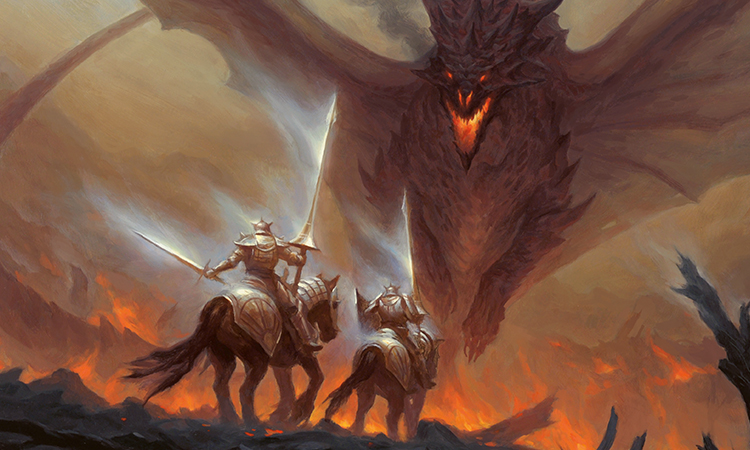
Path of Bravery | Art by Chris Rahn
Step Two: Generate Lots of Ideas Based on the Focus
Now that you have a jumping-off point (or a focus), it's time to come up with as many ideas inspired by the focus as you can. As I will explain, the creative process is an iterative loop—meaning that you will generate content based on a focus, evaluate the content arriving at a new focus, and then repeat this loop as many times as necessary. During the generation phases, what you want to do is start with your focus, whatever it is, and create a quantity of ideas. You're just trying to create anything and everything you can using your focus as inspiration. Note that the goal here is to create a lot of different kinds of things, so it's okay to focus on one area for a while—but make sure you mix it up and experiment in many different spaces.
Let me get into another important aspect of creation. There are two lenses by which you observe what you create. I call these lenses the heart and the head. The heart is your emotional filter, based on how things make you feel. Your head is your intellectual filter, based on how things make you think. During generation, you want to focus more on your heart. Don't worry about the logic of what you are creating. Just create. Make things that you are inspired to make. There are no rules during creation. Nothing is off limits. Things that might seem impossible or impractical can be steppingstones to wonderful ideas.
In Magic design, this is the earliest step where I tell my designers what area I'm interested in and then send them off to design whatever they want to using the focus I've given them. For Zendikar, we designed land mechanics. For Innistrad, we designed things inspired by the horror genre. For Ravnica, we designed to match the feel of the guilds. In each case, I chose a bullseye for my design team to focus on and then let them design anything and everything that idea inspired.
Step Three: Evaluate What You Have Generated
For this next part, it is time to shift from your heart to your head. You now have to look at all of the material you processed and evaluate it. Here is a simple way to do it: Make three boxes. The first box is for ideas you like. The second box is for ideas you don't like. The third box is for ideas you are unsure of. The reason the third box exists is because sometimes it's hard to understand in the moment how you feel about something, and often those things can prove to be valuable with more understanding later in the process, so I don't want you losing them just because you don't know for sure if you like them.
Another important thing to understand is that you are not evaluating the things you created in the context of your focus. You are looking at them in a vacuum. Do you like what you've created? If generation is about quantity, evaluation is about quality. This step is about determining the value of the items you generated. Once again, this is more a judgment of your head than your heart.
Once you have separated your work into the three boxes, here's what you do next. First, throw out all the items in the second box. You need not worry about them anymore. Next, look in the first box. See if all the things you like share some common through line. Is there a theme or a unifying aspect that ties many of them together? From this, you're going to craft a focus. It may be the same focus from the previous step but with a little more direction. It might be a similar focus but with a new aspect added to it. It might be a completely different focus. The key here is that you take the work you most enjoy and you see what the common thread is that runs through it.
After you do this, you then check the third box to see if anything in it falls into the new focus you've created. You don't need to get rid of the things that don't, but in the next stage you're not going to worry about anything outside your new focus.
In Magic design, this is the part where we playtest what the design team has come up with. The one thing we're trying to evaluate is whether or not the cards or mechanics or themes or whatever play well. This is the part where we determine whether the design elements are things we want to keep looking at or dispose of. It also helps me, as the lead designer, consider what we want to do with our next generation push. For example, in Zendikar, I started by asking the team for any kind of land mechanics that they could come up with. We then playtested them and started to figure out which design veins looked fruitful and which ones appeared to be dead ends.
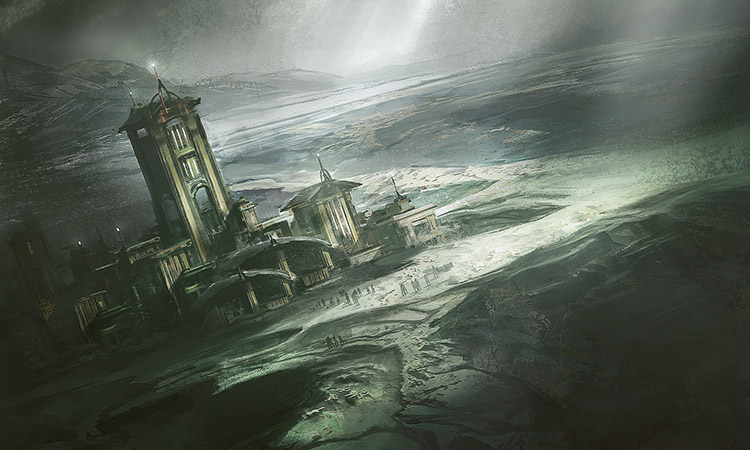
Kabira Crossroads | Art by James Paick
Step Four: Iterate on Steps Two and Three until You Lock Your Focus
I've talked many times about the role of iteration in design. You create, you judge, you make changes, and you continue the loop. In early creation, this iteration loop is about trying to figure out what exactly it is that you want. Just as you attend classes at college, you use the early part of the creative process to sample all of the things that are available. Note that you let your heart lead you where it wants during generation and then use your head to lend a critical eye during evaluation.
The idea behind this step is that in each loop of the iteration you are trying to inch closer to understanding what it is you want. The constant readjustment of the focus will allow your head to steer into areas that have proved fruitful, and then allow your heart to explore these rich creative veins. The constant readjustment is crucial, because you want to always ask your creative self to start from a different vantage point.
The reason for this is simple physiology. The brain wants to always work as efficiently as possible—so whenever it faces a task it's handled before, it will return to the exact same pattern of synapses to solve the problem. After all, that's how it was solved last time, so why not go with what works. The problem from a creative standpoint is that you don't want the same output. Yes, that's good when you're trying to brush your teeth, but in a creative exercise, the goal is to generate new material.
The evaluation step also can do important work in understanding why things are and aren't working. This is simply the value of getting emotional distance. It's why it's so hard for you to understand your own romantic relationships, for example, but so much easier to see things in others'.
The iteration allows you to, little by little, circle in on finding what you need. This step is done when you have a handle on the basics of what your creative process is going to be about.
My Magic example for this step is going to be Khans of Tarkir. We started with the idea of having a large-small-large block structure where the middle set drafted with each of the large sets but the two large sets were never drafted together. Exploration of what that draft structure meant led us to a time-travel story structure where the main character goes back in time and changes something that fundamentally shifts the timeline. That, with much help from the creative team, allowed us to get to the idea of Sarkhan's home world. It would start as a world of humanoid warlords where the Dragons had been wiped out, and end with a world where the Dragons were the warlords. Exploration of how to represent the warlord clans got us to factions, which then ultimately led us to the idea of making the wedge set that players had been asking for.
In Magic design, this iteration loop overlaps with the part of design we call the vision phase, where the design team is trying to figure out the basics of what the set is about. It's where we create the simple structure and do the first pass on the mechanics.
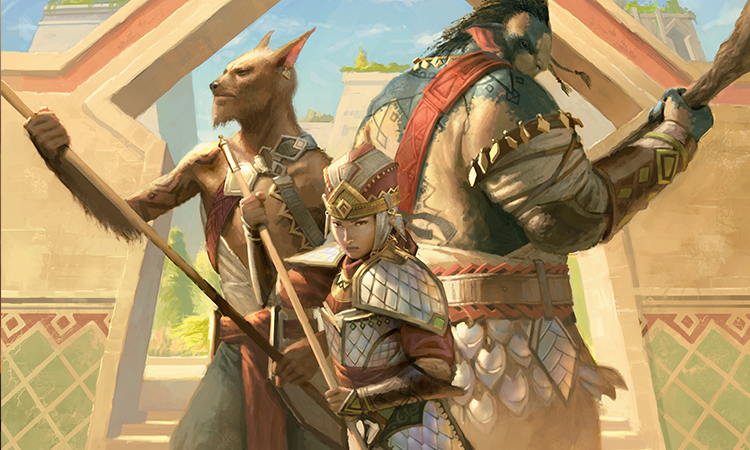
Incremental Growth | Art by Clint Cearley
Step Five: Generate Ideas within the Structure You've Created
The last iteration was about brainstorming and blue-sky design. There you were trying to create anything and everything that fit your theme. This next batch of generation is much more directed. You are trying to create the pieces needed to build your structure. If you are telling a story, this is the part where you start writing actual scenes. If you're painting a picture, this is the part where you begin applying brush strokes to the finished product. If you're making a Magic set, this is where you are starting to fill in your design skeleton—you're making the common green Giant Growth variant or you're filling out your creature curve.
It's very possible that during the last section, while you were trying to figure out what you were doing, you made a lot of usable pieces. You definitely sketched out the framework of what you needed and had elements from your first or third box that slotted right in. This batch of creative work is about figuring out what wasn't made yet and making it. Again, this generation is heart-led, meaning that you still want to be inspired. Make creative elements that tickle your sensibilities. You can stretch to make things fit and still try out some crazy ideas. It's okay to take many attempts at the same goal. In fact, some of the best work here will be when you try to solve the same problem multiple different ways.
The important point of this cycle of generation is that you are trying to fill in the gaps of whatever creative endeavor you are working on. The goal here is to make sure you have at least one option for every gap in your creative work.
My example here from Magic design will be original Ravnica. We had settled on the guild structure. We had come to grips with what each guild represented. We had made guild mechanics we liked. This batch of work was about figuring out what mechanical pieces we were missing to make each guild play the way we wanted it to. We made cycles both to show the similarities of the guilds and to also highlight their differences. We designed cool individual cards that captured the guild essences we were trying to convey. We knew clearly what we wanted, but there was a lot of work to find the best way to execute it. The "gaps" in a Magic set are cards, which means you want to walk out of this step with at least one card choice for each slot.

Compulsive Research | Art by Michael Sutfin
Step Six: Evaluate Your Work Using Outside Input
This evaluative step has three parts. First, you want to take all the work generated for each missing component and choose one option to fill each gap. (Occasionally, you will leave multiple options if you are interested in seeing how each of them feel. This works better in some media, like games, than others.) The goal here is to have a complete, if rough, version of whatever you're creating.
The second step is the full evaluation of the creative work. What makes this evaluation different from the previous batch of evaluations is two things. First, you are judging not just the components but also the whole of the creative endeavor. Second, you (or your team) are not judging in isolation. This step involves starting to get input from outside sources. If your creative work is collaborative, using people or teams outside your design group, this is the step where you begin looping them in for feedback. This is also the place where you try to get a sense of what your audience will think, often by sampling people who are representative of that audience.
The third part is figuring out what is working and what is not. This is similar to the three-box exercise but is more about recognizing which pieces of your work are shining. The goal is to recognize those pieces and then see if there are connective elements between them. You want to walk away from each evaluation with some new observation about what successful elements you want to expand upon. You can also do the opposite, which is to find out which elements aren't working, remove them, and look to see if other parts of your creative work also suffer from a similar problem.
In Magic design, this is the part where you start seeking feedback from other groups such as development or creative (note that in Magic design you have a representative for each on the design team, so you've already been getting some internal feedback). This is also the time to start having playtests with outside groups. At Wizards of the Coast, that often means other employees who are Magic players but who don't work in R&D. Although you come out of the vision phase with cards and mechanics, everything is still up for review and major changes can still happen.
Step Seven: Iterate on Steps Five and Six
This iterative loop is similar to the last one, but with a slightly different set of goals. Now instead of finding what your work is about, you're iterating on execution. For each component of your creative work, you're trying to make sure you have the best version. Just like the last batch of evaluations, you still want to choose a focus for each iteration so that you have some clarity to what you are generating. The big difference here, though, is the end results need to be tactical executions.
The one other big change is that this cycle of iterations should be shorter than the last. As you shift focus from the macro to the micro, the durations of your iterations need to shorten.
In Magic design, we call this the integration phase. This is where we ask all the other teams to kick the tires and make sure that we are not making choices in our design that are going to cause them trouble. Usually, we refer to these as passes, and it is quite common that each pass has a specific goal—looking at a particular mechanic or a certain draft archetype, for instance. We then do playtests to see how our new changes are working, generating new feedback to evaluate. Big changes can happen during this phase. For example, it was during this time in Scars of Mirrodin that we decided to back things up and make the first set about Mirrodin before the war with the Phyrexians. (We had started with the idea that the first set was already New Phyrexia.)
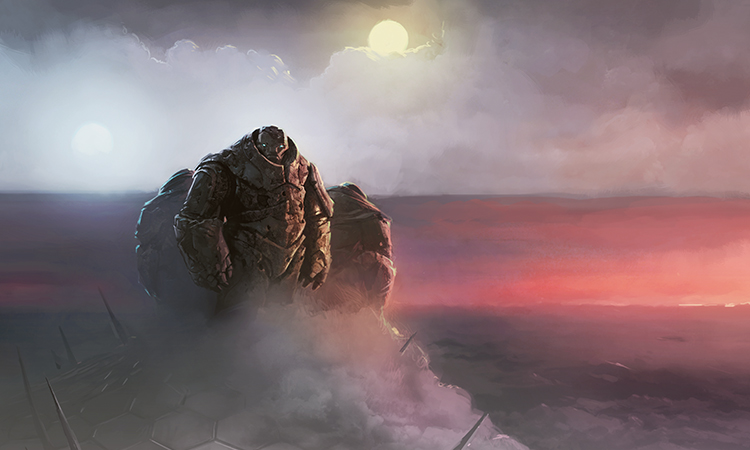
Precursor Golem | Art by Chippy
Step Eight: Generate Changes within the Components
The first phase is about figuring what your creative work is about. The second phase is finding the right pieces to make up your creative work. This final phase is about fine-tuning the pieces you have. This is the most micro-centric of the work, as you are studying the details of each choice you've made.
Most people think about this part of the creative process as polish. You are making the final steps you need before you release your creative work to the public at large.
In Magic design, this is where you start doing file passes to look at each individual card. The notes out of playtesting stop being about larger issues and start being about specific cards.
Step Nine: Evaluate the Minutiae
Each evaluative step reduces the focus of what it's paying attention to—first the structure, then the components, and finally the details. An important part of this evaluation is to make sure that your details are being consistent with one another. Changing one small thing in one section of your creative work will often mean changing it in various other places as well.
A big difference between generating the changes and evaluating the changes goes back to the heart and head separation I talked about at the beginning. When you are generating new content, be it whole elements or just details, you want to be doing things that emotionally excite you. You want to create from a place that's emotionally fulfilling. When evaluating, though, you want to use your head because you need to ask yourself the hard question of whether or not each element is maximizing its function. It doesn't matter if you like an element at this point; all that matters is whether it's doing the job it needs to do.
In Magic design, these are the late playtests where most of the notes are card-by-card notes. Usually the lead designer has a pad of paper on hand, and whenever an issue with a card comes up, it's written down. Also, you want to read over the notes of the playtesters to see if there are comments from multiple players that dictate a larger issue at hand that needs to be looked at.
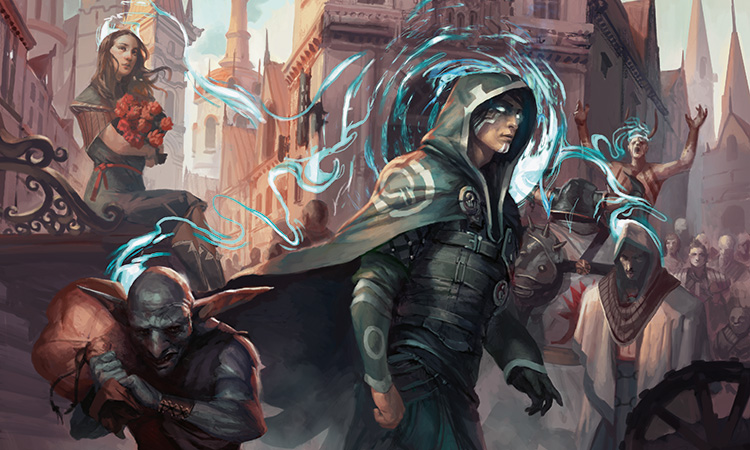
Talent of the Telepath | Art by Peter Mohrbacher
Step Ten: Iterate on Steps Eight and Nine
This last series of iterations is the shortest. You generate changes, evaluate those changes, and make notes that will lead to future changes. You don't need to make many changes during each of these iterative cycles. Change the few things you need to do and re-evaluate.
In Magic design, this last phase is called the refinement phase. This is all about crossing your t's and dotting your i's. This is about looking at every card with a fine-tooth comb and making sure that all the details are what you want. This is where you want the rules manager to do a pass as well as the editor, to check for templating issues. You are just about to hand off the file to development, so you also are in close contact with the development team that has already started up (as you are in the design portion—the overlap between design and development).
Step Eleven: You're Finished
Step eleven is hard because you can stay in the last iterative loop forever. There is always something you can improve and it's hard to let go, but with every creative work that time will come. Magic design has a deadline, which helps make this final step a little easier, as the timing is out of your hands.
Looking back, this whole process breaks down into three phases, each involving three steps. At each phase you will generate material, which you will evaluate and then iterate on the process until you have completed what you need. For shorthand, you can think of these steps as generate, evaluate, and iterate.
The three phases (I'll use the R&D design names) are vision, integration, and refinement. Vision is about figuring out what your creative work is about, which usually involves creating the structure and filling much of it in. The integration phase is about finishing filling in the missing components and then seeking outside feedback. The refinement phase is about attention to detail and making sure everything is working within each component.
The Filled Page
And that is my take on a way to think about the creative process from blank page to completed project. As always, I'm very eager for feedback on today's column. You can write to me through email or contact me through any of my social media accounts (Twitter, Tumblr, Google+, and Instagram).
Join me next week when I talk about being a team player.
Until then, may the blank page scare you a little less.
"Drive to Work #280—Bad Cards Revisited"
Last podcast, I revisited a famous old article of mine about why we make bad cards ("When Cards Go Bad"). This podcast is about the follow-up article I wrote revisiting the original article ("When Cards Go Bad Revisited").
"Drive to Work #281—Social Media"
In this podcast I talk about being one of the game's spokespeople and about how I use social media to connect with fans.
- Episode 281 Social Media (16.7 MB)
- Episode 280 Bad Cards Revisited (21.2 MB)
- Episode 279 Bad Cards (14.1 MB)
- Episode 278 Fate Reforged, Part 5 (15.3 MB)
- Episode 277 Fate Reforged, Part 4 (18.5 MB)

